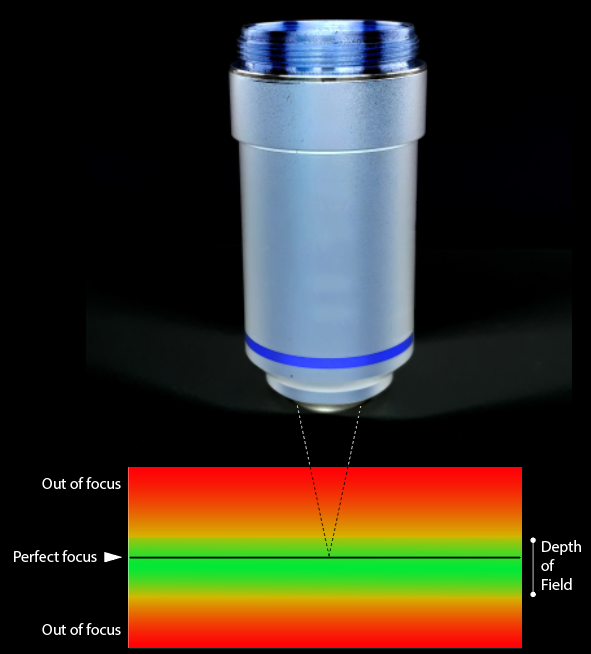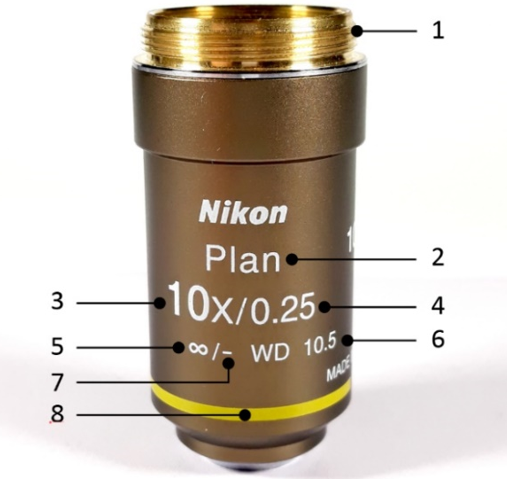In this section I introduce an outrageous subject, one that often makes for sleepless nights and brings adrenaline rates close to hospitalization… that is: how many shots does the camera need to take in order to get a subject fully in focus when using a microscope lens?
Dozens? Hundreds? How many?
I do not enter into the subject of optics and physics of light (also because I haven’t the knowledge), but at least one thematic to understand how to parameterize our system must be addressed, that is to understand what the Depth of Field (DOF) is.
In simple terms, the DOF is the distance between the nearest and furthest part of the object with respect to the lens, that is acceptably sharpen and in focus. If you move further away (or get closer to the lens) the image will be out of focus, blurred, and you will need to move the lens (or the subject) to see more of it.

The value of DOF is a function of the numerical aperture of the lens (NA), the magnification (M), the resolving power of the human eye, the wavelength used. Some values (such as wavelength and resolving power) are constant, while NA and M are technical characteristics of the lens used and are often indicated on the barrel, or otherwise easy to find at the manufacturer.
The numerical aperture is the value that most affects the DOF, which is inversely proportional, so that a higher value of numerical aperture corresponds to a lower value of DOF, and vice versa.

General description of a lens: 1- Mounting thread; 2- Type of correction on optical aberration (Optical Aberration Correction); 3- Magnification; 4- Numerical aperture; 5- Image distance; 6- Working distance; 7- Cover glass thickness; 8- Magnification color code.
There is a simplified formula that is generally used when using objectives for microscopy and that is expressed as DOF = 0.00055/(NA * NA), this formula and other interesting tables are available on the site : http://zerenesystems.com/cms/stacker/docs/tables/macromicrodof .
This formula works if the objective is used at the nominal magnification. If you would like to use a 5x objective at 10x, the DOF will change, but also the quality of the image, increasing the risk to have more vignetting, chromatic aberration, and a general loss in image quality.
Based on the value obtained from the above formula, we can set the movement of the motor and the advancement of the acquisition system. According to the size (the thickness) of the object, you’ll need to acquire a greater or lesser number of steps; a relatively flat object will obviously require a lower number of steps than a spherical subject. You can consider the single steps as lasagna slices that make up a nice baked pasta. Every single slice of lasagna is a step, and the whole corresponds to what you have in the dish (never enough…)
Keep in mind that, in order to have the whole subject in focus, we must consider an overlap between successive steps of a value of 20-30%. In this way we can make sure to get a good final result, at the expense of a few extra images (and that never hurts). The process of merging frames is done by specialized software (Helicon Focus and Zerene Stacker are the most widely used), and the partial overlap between successive images allows the software to be able to “stitch” the parts together, resulting in a complete in focus subject.
As an example, I’ve acquired a grain of black pepper with three different lenses, but with a magnification approximately similar: a russian LOMO 3.7x, a PLAN 4x and a japanese Mitutoyo 2.5x (pushed to ~4.7x).
The result of the three acquisitions can be seen in the following picture:

Although the result is almost the same if you compare the three images obtained (I do not enter into the quality of the objectives, perhaps the subject of future discussion) it is important instead to compare the number of images that were required to acquire the entire surface of the subject (the total includes an overlap between successive steps of 20%):
Mitutoyo “4.7x” NA= 0.14 (DOF of 28µm) 287 images
PLAN 4x NA= 0.1 (DOF of 55µm) 155 images
LOMO 3.7x NA= 0.11 (DOF of 45.4µm) 158 images
This difference, which is also notable between the Mitutoyo “4.7x” and the other two objectives, is justified by the fact that the numerical aperture NA of the Mitutoyo is 0.14, while the LOMO is 0.10 and the PLAN 0.11, and we have seen that a higher value of NA corresponds to a lower value of DOF
Comparing the image of a frame acquired with the Mitutoyo (left) and the same image acquired with the LOMO (right) we can see that the DOF is lower in the Japanese lens, requiring a greater number of steps – and frames – to cover the entire subject, compared to the Russian one. The latter has a higher DOF and, consequently, there are fewer images to capture. The white band indicates approximately the area where the image is acceptably sharp.

In conclusion, it is important to know these simple parameters before embarking on capturing an outrageously high number of frames (which will take up Gb of space on your disk and waste of time to process the images).
Below is an animated example of image stacking. Every frame is focused only on a slice of the whole subject: the combination of all the slices make up the final picture. The animation is composed of 83 images, with a step of 95µm (with a reversed Schneider-Componon 50mm/f2.8 ). The subject is an isopod in ventral view, from the Dominican Republic.

Experience will then allow you to refine your technique and optimize your acquisition processes.
Happy stacking!
